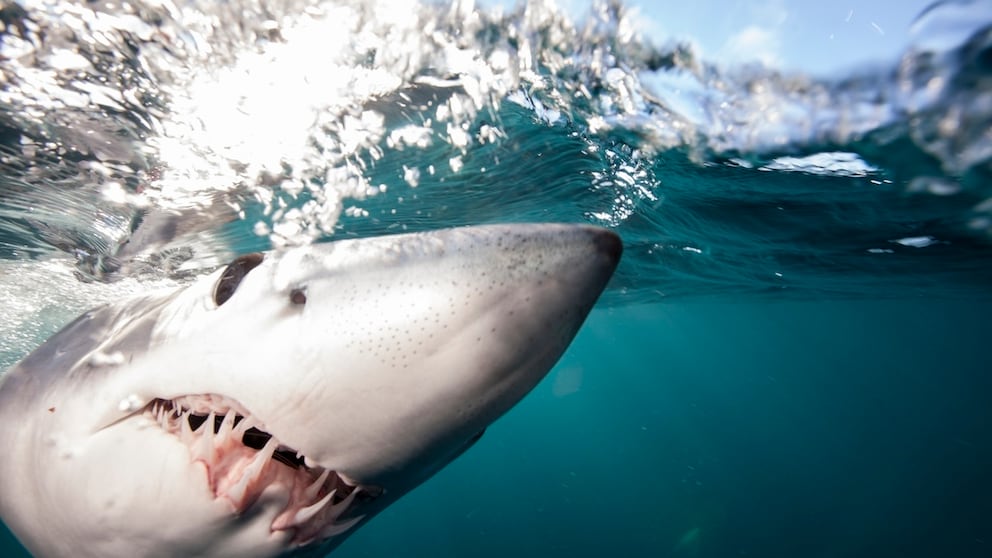March 23, 2025, 9:43 am | Read time: 4 minutes
A sight that even experienced marine biologists don’t see every day: An octopus clings to the head of the world’s fastest shark — and is comfortably carried away. What this unusual encounter is all about raises more questions than answers.
Do you know the movie “Sharktopus”? For many fans of cult cinema, this low-budget film is a beloved classic. Not to mention the glorious sequels to this masterpiece in which Sharktopus first had to compete against Pteracuda (a mix of Pterodactyl and Barracuda) and later against Whalewolf, a mix of werewolf and whale. However, when the prestigious University of Auckland (Waipapa Taumata Rau) in New Zealand refers to a “sharktopus,” they are describing something equally astonishing: An octopus that simply clings to the fastest shark in the world and rides it through the waves.
How the Cctopus Managed its Shark “Mount” Is Uncertain
During a research cruise by the University of Auckland, an orange octopus was observed clinging to a shortfin mako (Isurus oxyrinchus), a shark renowned for its incredible speed. The unusual pair was discovered in the Hauraki Gulf off the North Island of New Zealand.
“A large, metallic gray dorsal fin suggested a large shark, a shortfin mako. But wait, what was that orange spot on its head? A buoy? An injury?” Rochelle Constantine, a marine biologist at the University of Auckland, described the moment of observation in a statement from the university. “We launched the drone, plunged the GoPro into the water, and saw something unforgettable: an octopus sitting on the shark’s head, holding on with its tentacles.”
The scientists were truly amazed at this bizarre sight. While mako sharks are usually found in the open water zone near the surface, octopuses are mainly found on the bottom. “We really don’t know how this octopus, which lives on the seabed, came across this three-meter-long mako that lives in the open ocean. It’s really a mystery — but the ocean is full of unexpected things,” Constantine told LiveScience via email.
Shark Probably Didn’t Notice the Blind Octopus Passenger
The scene was observed for around ten minutes before the researchers left the shark and its animal passenger to their own devices. According to Constantine, the shark showed no reaction to its companion. “The shark appeared undisturbed by the octopus, continuing to swim at a leisurely pace. The cephalopod simply held all its tentacles together on the shark’s head, perhaps to avoid being seen. “I suspect that it would have detached itself if the shark had swum faster.”
In her university’s announcement, Constantine further cherishes the encounter with the “sharktopus” as a reminder of the wonders of the ocean. “One of the best things about being an ocean explorer is that you never know what you might see next in the ocean. By supporting conservation initiatives, we can help ensure that such extraordinary moments continue to be possible.”
However, the questions of how the octopus got to see its “ride” in the first place or whether octopuses often exhibit this behavior remain unanswered. It also remains unclear which species of octopus it was. However, it could be Macroctopus maorum, the “Maori octopus.” It is either orange-brown, like in the video, or dark purple-grey. It is also known not to have a fixed habitat but to use various hiding places. Could it be that the octopus uses this “shark taxi” as a means of transportation from one location to another? 1

Specialized strategy Orcas observed hunting the world’s largest sharks for the first time

Fatal Within Minutes The Most Poisonous Animals in the World

Phenomenon Explained Why Dolphins Love Surfing on Waves and Next to Boats
Shortfin Mako — Fast, Agile and Endangered
However, its mount, the shortfin mako, has been clearly identified by marine biologists. It is considered the fastest shark species in the world and, according to various reports, reaches speeds of 50 to even 80 km/h at its peak. This makes it significantly swifter in the water than the formidable great white shark.
The animals can grow up to four meters long and weigh up to 500 kilograms. Their leaping ability is particularly impressive, with the capability to spring up to six meters out of the water. This allows them to hunt other fast fish, and they will not even stop at whole tuna or swordfish.
Despite their impressive abilities, shortfin makos are highly endangered. They are classified as “endangered” on the IUCN Red List, in part because of their high value in the shark fin trade. In addition, they are often unintentionally caught as bycatch in fishing nets, especially when using longlines that fish at greater depths. Their low reproductive rate makes it difficult for them to recover from such losses.


